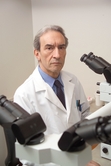Lymphoblastic lymphoma of childhood and the LSA2-L2 protocol: The 30-year experience at Memorial Sloan-Kettering Cancer Center Journal Article
| Authors: | Mora, J.; Filippa, D. A.; Qin, J.; Wollner, N. |
| Article Title: | Lymphoblastic lymphoma of childhood and the LSA2-L2 protocol: The 30-year experience at Memorial Sloan-Kettering Cancer Center |
| Abstract: | BACKGROUND. Until the 1970s, diffuse lymphoblastic lymphoma (DLBL) was considered incurable. With intensive multidrug regimens, the majority of patients can now be cured. In the current study, the authors present what to their knowledge is the longest follow-up presented to date (median, 20 years for survivors) of the largest group of DLBL patients treated with a single protocol at a single institution. METHODS. Between 1971-1990, a total of 95 consecutive patients (age < 21 years) with DLBL were treated with the LSA2-L2 protocol at the Memorial Sloan-Kettering Cancer Center (MSKCC). Patients with Stage I-II disease were treated for 2 years. In 1980, the protocol was modified and patients with Stage III and IV disease were treated for 3 years. In addition, before the modification, patients with Stage IV disease received a cumulative dose of 15,600 mg/m2 of cyclophosphamide for 3 years; after 1980, these patients received the same dosage as the other patients (i.e., 8400 mg/m2 for 2 years). Radiation therapy initially was administered to all patients with bulky disease in the primary tumor site. Until 1977, the dose of radiation was 20-55 grays (Gy); from 1977 to 1989, the dose was 20 Gy. After the fifth year of completion of treatment, all patients were evaluated comprehensively every 2 years. RESULTS. The overall survival (OS) of the patients was 79% with a median follow-up of 20 years. The overall event-free survival (EFS) was 75% (71 of 95 patients). Seventeen patients developed a disease recurrence and 15 died of disease. The OS and EFS rates for patients with Stages I-II disease (n = 8) were 87% and 87%, respectively, and the OS and EFS rates for patients with Stage III disease (n = 41) were 90% and 85%, respectively. The OS and EFS for patients with Stage IVA disease (with bone marrow [BM] involvement of < 25%) (n = 19) were 79% and 73%, respectively, whereas the OS and EFS for patients with Stage IVB disease (BM involvement of > 25%) (n = 27) were 74% and 70%. Of the 29 patients with Stage IV disease who were treated with the original protocol, 7 died of disease (1 of 8 patients with Stage IVA disease and 6 of 21 patients with Stage IVB disease). Of the 17 patients with Stage IV disease who were treated with the modified protocol, 3 died of disease (2 of 11 patients with Stage IVA disease and 1 of 6 patients with Stage IVB disease). Six patients developed secondary malignancies, four of whom died. CONCLUSIONS. Long-term EFS can be achieved in the majority of patients with widely disseminated pediatric DLBL. Chemotherapy alone appears to be sufficient prophylaxis against disease recurrence in the central nervous system. No disease-related or treatment-related deaths were reported to occur > 4.5 years after diagnosis in the current study. © 2003 American Cancer Society. |
| Keywords: | adolescent; adult; cancer chemotherapy; child; treatment outcome; child, preschool; disease-free survival; survival rate; major clinical study; hydroxyurea; prednisone; radiation dose; cytarabine; methotrexate; cancer staging; follow up; follow-up studies; neoplasm staging; tumor localization; metastasis; tumor volume; antineoplastic combined chemotherapy protocols; radiotherapy dosage; cyclophosphamide; vincristine; cancer mortality; carmustine; acute lymphoblastic leukemia; childhood cancer; cancer center; nonhodgkin lymphoma; lymphoma, non-hodgkin; tumor recurrence; prophylaxis; daunorubicin; asparaginase; second cancer; tioguanine; male infertility; lymphoblastoma; leukemia, lymphocytic, acute; lymphoma, lymphoblastic; humans; prognosis; human; male; female; priority journal; article; acute lymphoblastic leukemia (all); diffuse lymphoblastic lymphoma (dlbl); lsa2-l2 protocol; non-hodgkin lymphoma (nhl) |
| Journal Title: | Cancer |
| Volume: | 98 |
| Issue: | 6 |
| ISSN: | 0008-543X |
| Publisher: | Wiley Blackwell |
| Date Published: | 2003-09-15 |
| Start Page: | 1283 |
| End Page: | 1291 |
| Language: | English |
| DOI: | 10.1002/cncr.11615 |
| PUBMED: | 12973853 |
| PROVIDER: | scopus |
| DOI/URL: | |
| Notes: | Export Date: 12 September 2014 -- Source: Scopus |
Altmetric
Citation Impact
BMJ Impact Analytics
MSK Authors
Related MSK Work




